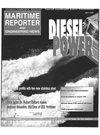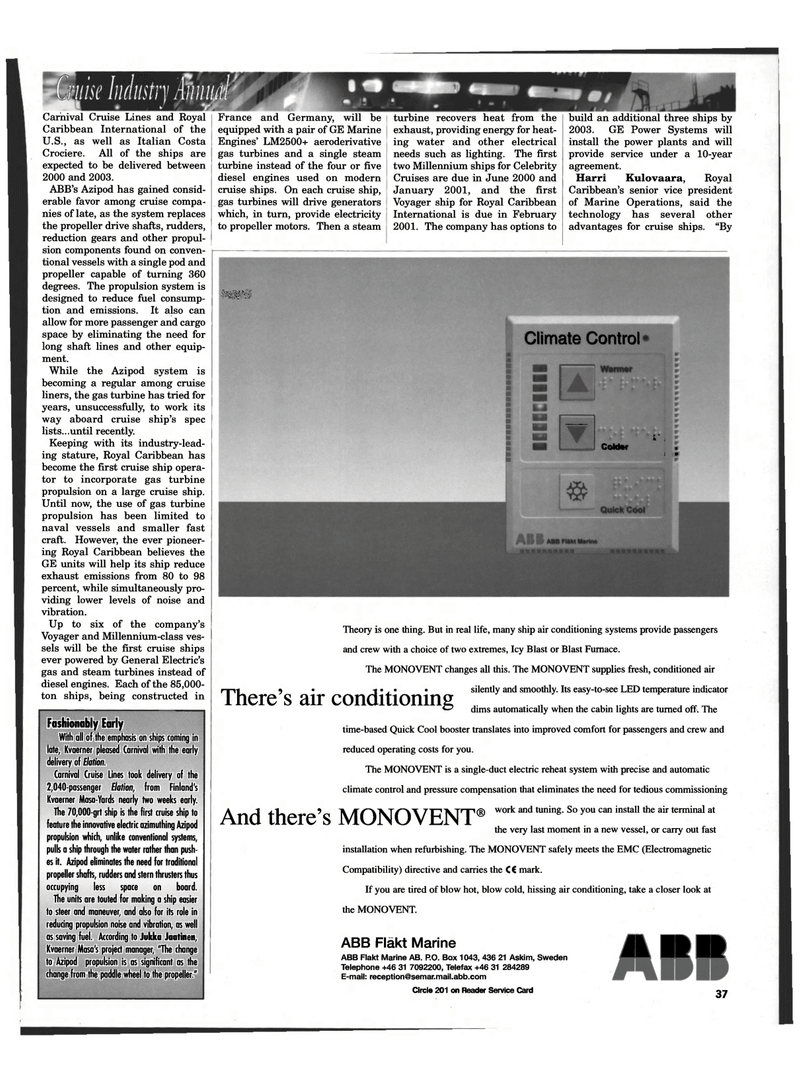
Page 37: of Maritime Reporter Magazine (July 1998)
Read this page in Pdf, Flash or Html5 edition of July 1998 Maritime Reporter Magazine
Carnival Cruise Lines and Royal
Caribbean International of the
U.S., as well as Italian Costa
Crociere. All of the ships are expected to be delivered between 2000 and 2003.
ABB's Azipod has gained consid- erable favor among cruise compa- nies of late, as the system replaces the propeller drive shafts, rudders, reduction gears and other propul- sion components found on conven- tional vessels with a single pod and propeller capable of turning 360 degrees. The propulsion system is designed to reduce fuel consump- tion and emissions. It also can allow for more passenger and cargo space by eliminating the need for long shaft lines and other equip- ment.
While the Azipod system is becoming a regular among cruise liners, the gas turbine has tried for years, unsuccessfully, to work its way aboard cruise ship's spec lists...until recently.
Keeping with its industry-lead- ing stature, Royal Caribbean has become the first cruise ship opera- tor to incorporate gas turbine propulsion on a large cruise ship.
Until now, the use of gas turbine propulsion has been limited to naval vessels and smaller fast craft. However, the ever pioneer- ing Royal Caribbean believes the
GE units will help its ship reduce exhaust emissions from 80 to 98 percent, while simultaneously pro- viding lower levels of noise and vibration.
Up to six of the company's
Voyager and Millennium-class ves- sels will be the first cruise ships ever powered by General Electric's gas and steam turbines instead of diesel engines. Each of the 85,000- ton ships, being constructed in
France and Germany, will be equipped with a pair of GE Marine
Engines' LM2500+ aeroderivative gas turbines and a single steam turbine instead of the four or five diesel engines used on modern cruise ships. On each cruise ship, gas turbines will drive generators which, in turn, provide electricity to propeller motors. Then a steam turbine recovers heat from the exhaust, providing energy for heat- ing water and other electrical needs such as lighting. The first two Millennium ships for Celebrity
Cruises are due in June 2000 and
January 2001, and the first
Voyager ship for Royal Caribbean
International is due in February 2001. The company has options to build an additional three ships by 2003. GE Power Systems will install the power plants and will provide service under a 10-year agreement.
Harri Kulovaara, Royal
Caribbean's senior vice president of Marine Operations, said the technology has several other advantages for cruise ships. "By
Fashionably Early
With all of the emphasis on ships coming in late, Kvaerner pleased Carnival with the early delivery of Elation.
Carnival Cruise Lines took delivery of the 2,040-passenger Elation, from Finland's
Kvaerner Masa-Yards nearly two weeks early.
The 70,000-grt ship is the first cruise ship to feature the innovative eledric azimuthing Azipod propulsion which, unlike conventional systems, pulls a ship through the water rather than push- es it. Azipod eliminates the need for traditional propeller shafts, rudders and stern thrusters thus occupying less space on board.
The units are touted for making a ship easier to steer and maneuver, and also for its role in reducing propulsion noise and vibration, as well as saving fuel. According to Jukka Jaatinen,
Kvaerner Masa's project manager, "The change to Azipod propulsion is as significant as the change from the paddle wheel to the propeller." lapis
Climate Control
Colder r: r ; r
There's air conditioning
Theory is one thing. But in real life, many ship air conditioning systems provide passengers and crew with a choice of two extremes, Icy Blast or Blast Furnace.
The MONOVENT changes all this. The MONOVENT supplies fresh, conditioned air silently and smoothly. Its easy-to-see LED temperature indicator dims automatically when the cabin lights are turned off. The time-based Quick Cool booster translates into improved comfort for passengers and crew and reduced operating costs for you.
The MONOVENT is a single-duct electric reheat system with precise and automatic climate control and pressure compensation that eliminates the need for tedious commissioning (g) work and tuning. So you can install the air terminal at the very last moment in a new vessel, or carry out fast installation when refurbishing. The MONOVENT safely meets the EMC (Electromagnetic
Compatibility) directive and carries the C€ mark.
If you are tired of blow hot, blow cold, hissing air conditioning, take a closer look at the MONOVENT.
And there's MONOVENT
ABB Flakt Marine
ABB Flakt Marine AB. P.O. Box 1043, 436 21 Askim, Sweden
Telephone +46 31 7092200, Telefax +46 31 284289
E-mail: [email protected]
Circle 201 on Reader Service Card
A IIII 37

 36
36

 38
38
